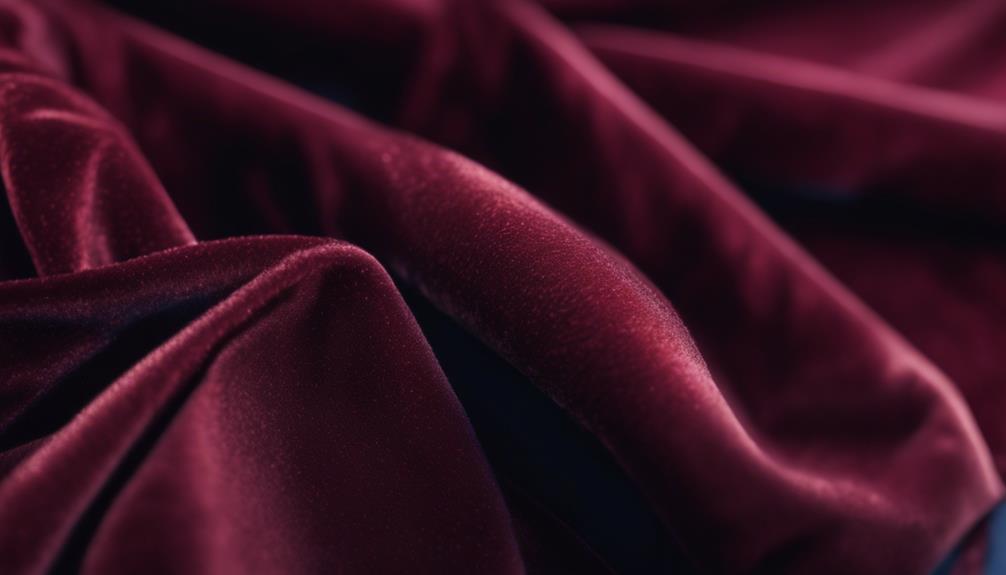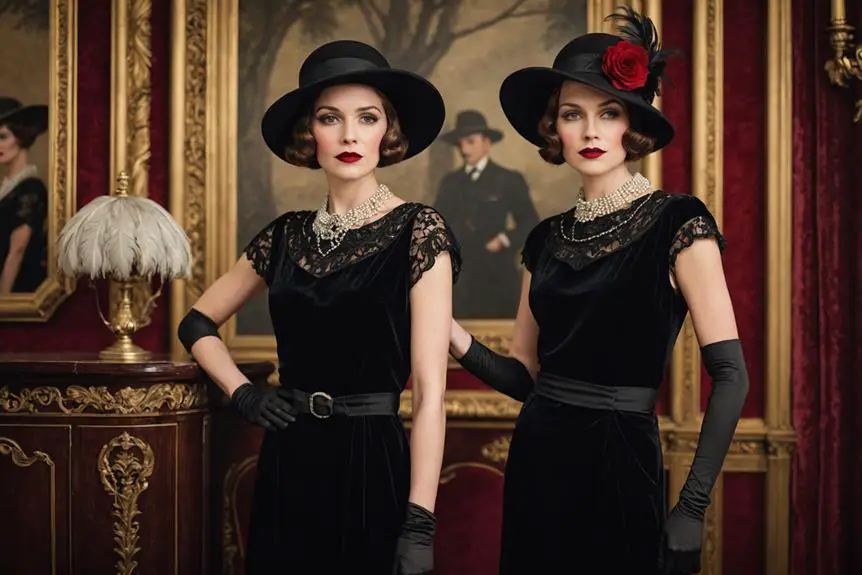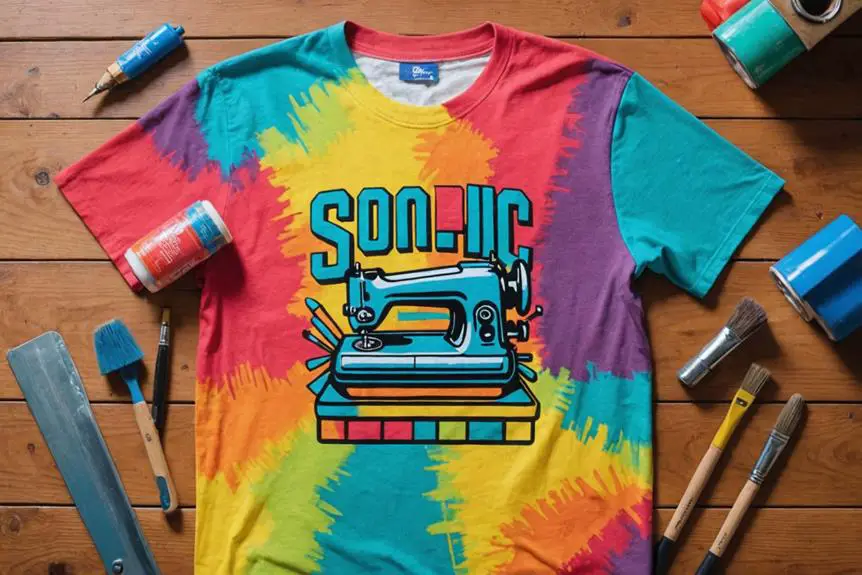To identify velour, look for its soft, plush texture and the dense pile that gives it a luxurious feel. You'll notice it's stretchy, thanks to its knit construction, which makes it comfortable. Check if it's made from cotton blends or synthetic fibers like polyester for added durability. Velour is usually used in casual apparel, so if you see it in loungewear or tracksuits, you've likely found it. It's distinct from velvet due to its more casual presentation, and recognizing these traits will help you spot velour in various applications. You might find more intriguing details ahead.
What Is Velour?
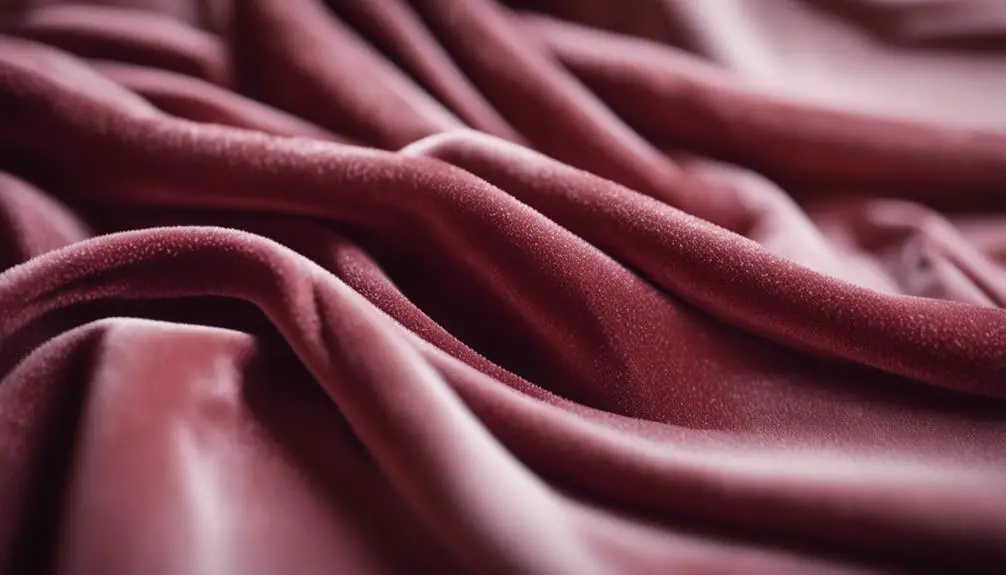
Velour is a soft, plush fabric that invites you to touch it with its dense pile. Typically made from a cotton blend or synthetic fibers like polyester, velour stands out due to its unique construction. It's a knit fabric, which allows it to stretch naturally, ensuring comfort and versatility in various garments.
The term "velour" comes from the French word for velvet, yet it's simpler and more affordable to produce than traditional velvet. Unlike velvet, velour features a shorter pile length and lacks the same luxurious sheen, giving it a more casual appearance. This makes it an excellent choice for loungewear, tracksuits, and home decor items.
You'll also find velour in stage curtains, as its durability and flame-retardant properties make it a practical option for performance settings. When you're shopping, look for those plush textures and the telltale softness of velour. Remember, whether you're wearing it or decorating your space, this fabric offers both comfort and style, bringing a cozy yet sophisticated vibe to any setting.
Characteristics of Velour
Identifying the characteristics of velour can enhance your shopping experience and help you choose the right fabric for your needs. Velour fabric is known for its soft, plush texture, thanks to its dense pile that gives it a luxurious feel. This medium-length cut pile often provides some stretch, making velour more elastic than traditional velvet.
You'll usually find velour made from cotton blends or synthetic fibers, particularly polyester, which boosts durability and makes care easier. One standout feature is its inherent flame retardant property, adhering to NFPA 701 standards, so you don't need to worry about special chemicals during laundering.
When shopping, you'll notice that velour is commonly used in casual apparel, like tracksuits, loungewear, and hoodies. This sets it apart from velvet, which tends to be used in more formal contexts. By keeping these characteristics in mind, you can confidently identify velour and appreciate its unique qualities, ensuring you select the right fabric for your intended use. Whether you're dressing down or enjoying a cozy night in, velour can add that perfect touch of comfort and style to your wardrobe.
Types of Velour Fabric
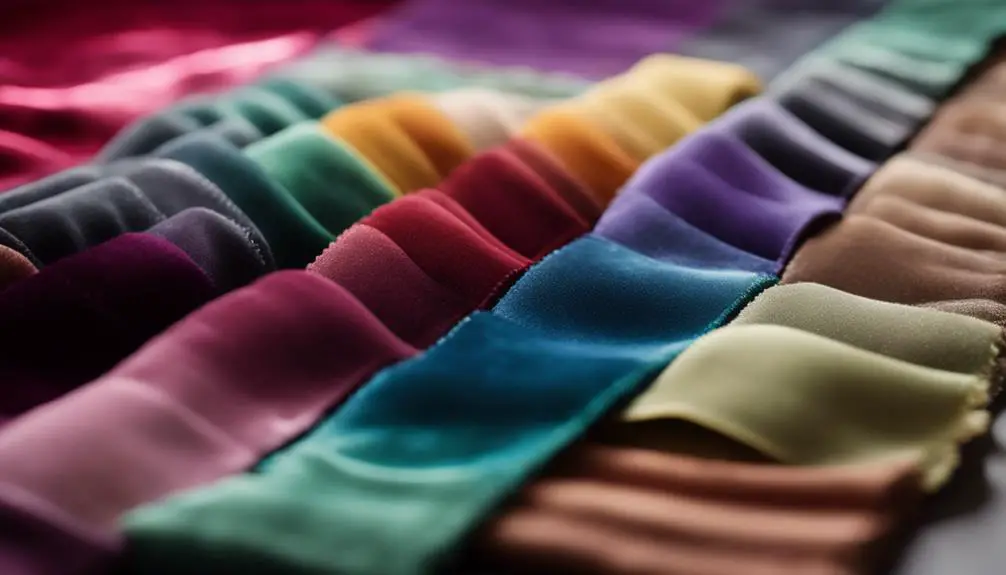
When it comes to velour fabric, you'll find several distinct types, each with unique characteristics that cater to different uses. Velour is usually categorized into different fabrics based on its construction and materials.
Knit velour features a terry construction that's sheared and brushed, providing natural stretch, making it a popular choice for sportswear and loungewear. On the other hand, woven velour is a soft, rigid fabric with a cut pile, ideal for more formal applications like suits and upholstery.
Cotton velour, traditionally predominant, is made from 100% cotton, offering a plush feel that works well for both apparel and home decor. If you're looking for something more budget-friendly and durable, synthetic velour, typically made from polyester, is the way to go; it's often used for stage curtains and theatrical applications.
Lastly, there's velour leather, which resembles suede and is often used in accessories like shoes and watch bands. Each type of velour fabric brings its own unique qualities, so understanding these differences helps you choose the right one for your needs.
Historical Background
Originating in France during the 1840s, velour emerged as an affordable alternative to the luxurious and costly velvet. Its creation stemmed from the need for a fabric that provided a similar look and feel without the hefty price tag. Initially crafted from cotton, velour has evolved over the years, with modern production frequently utilizing synthetic fibers like polyester. This shift not only enhances its affordability but also contributes to its versatility in various applications.
You might be surprised to learn that velour gained significant traction in the 1970s, shifting from upholstery to fashionable apparel. It became a staple in stylish tracksuits and elegant evening wear, capturing the essence of casual luxury. The fabric saw further resurgence in the 1960s and 1990s, aligning perfectly with the era's emphasis on comfort in clothing.
Today, velour remains synonymous with both luxury and comfort, making it a popular choice for clothing and home decor items alike. Its rich texture and elegant appearance continue to appeal to those looking for fashionable yet affordable options, ensuring velour's place in the fashion landscape for years to come.
Care and Maintenance
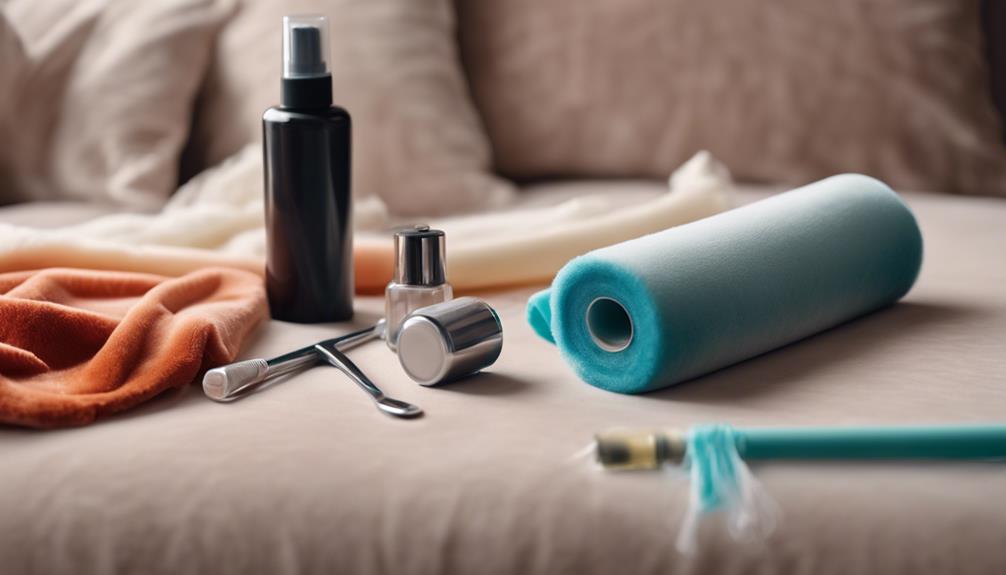
Taking care of velour is straightforward, making it a practical choice for both clothing and home decor. Most velour fabrics, especially knit velour, can be machine washed, which simplifies your cleaning routine. However, if you have woven velour, it might require special care like dry cleaning to maintain its texture and appearance. Always check the care label for specific instructions, as different velour types may have unique maintenance requirements.
To keep the plushness of your velour items intact, avoid ironing them. Instead, use steam to refresh the fabric without flattening the pile. This method helps preserve the luxurious feel that makes velour so appealing. Plus, you'll appreciate that velour doesn't wrinkle easily, so your garments and home decor will maintain a polished look over time.
Comparison With Other Fabrics
Velour stands out among fabrics due to its unique knit construction and soft, dense pile. When you compare it to velvet, you'll notice a key difference: velvet is a woven fabric, often made from silk or synthetic fibers, which results in a longer and more luxurious pile. This makes velvet feel thicker and softer, but it also means it's more delicate and often requires special cleaning methods.
On the other hand, velour's knit fabric gives it inherent stretch, making it more versatile for casual wear. Unlike velveteen, which has a shorter and stiffer pile primarily made from cotton, velour maintains a plush, stretchy surface that drapes well. While the sheen of velour is less pronounced than that of velvet, this gives velour a more laid-back appearance, suitable for everyday clothing.
Durability is another factor where velour shines; it's generally easier to care for than velvet, making it a practical choice for those who want comfort without the fuss. To summarize, understanding the differences between velvet and velour can help you choose the right fabric for your needs.
Environmental Impact
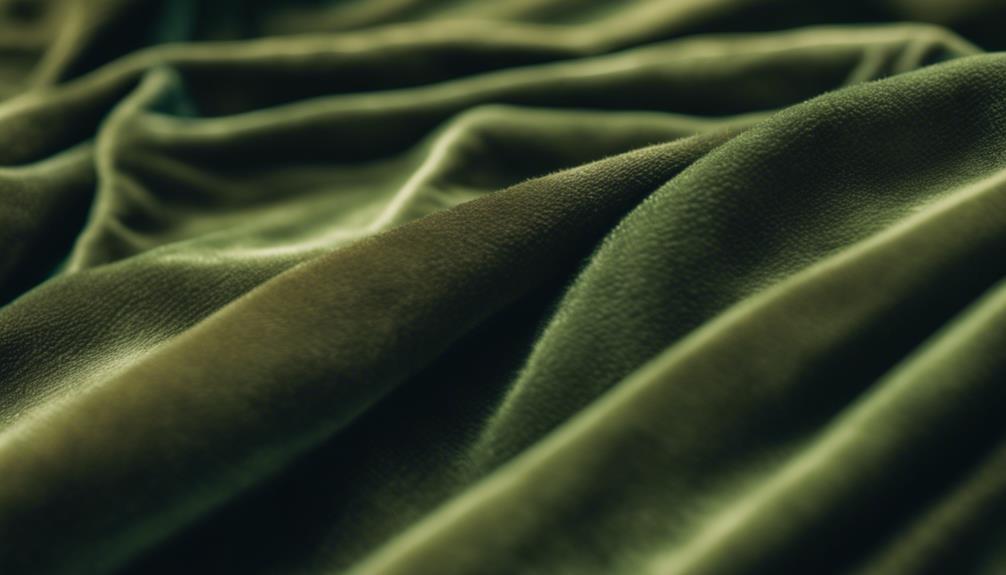
When considering the environmental impact of velour, it's important to weigh the pros and cons of its materials. Velour can be made from synthetic fibers like polyester, which contribute to microfiber pollution that harms marine ecosystems when washed. On the other hand, cotton velour is biodegradable and generally more environmentally friendly. However, keep in mind that its production can still consume significant water and involve pesticide use.
If you're looking for environmentally responsible options, look for certifications. USDA organic certification for cotton velour indicates sustainable farming practices, while OEKO-TEX certification guarantees the fabric meets certain environmental standards.
While the annual production of velour is relatively low compared to other textiles, the shift towards synthetic materials has increased its ecological footprint. This highlights the importance of selecting sustainable fabrics in your purchases. By being mindful of your choices, you can help mitigate the environmental effects associated with velour. Always consider the material source and its impact on the planet, so you can enjoy the luxurious feel of velour while supporting eco-friendly practices.
Practical Applications
Understanding the environmental impact of velour can enhance your appreciation of its practical uses. This versatile staple fabric finds its place in various applications, making it a popular choice. Here are three key uses of velour:
- Fashion: Velour's soft texture makes it ideal for casual fashion items like tracksuits and sweatshirts, as well as evening wear, giving you a stylish yet comfortable look.
- Home Decor: You'll often see velour used in upholstery for vintage furniture, decorative pillows, and cozy blankets, adding a touch of luxury to your living spaces.
- Specialty Uses: Velour is also employed to line jewelry boxes, protecting delicate pieces from scratches while adding an elegant touch.
Additionally, velour enhances theater productions as stage curtains, thanks to its flame-retardant properties and rich texture. Its unique feel and cultural associations also make it a staple in streetwear and niche markets. By recognizing these practical applications, you can better appreciate how velour contributes to both fashion and functionality in everyday life.
Frequently Asked Questions
How Can You Tell if Something Is Velour?
You can tell if something's velour by feeling its soft, plush texture and checking for a slight stretch. Look for a shiny surface and lighter weight compared to velvet, which has a heavier drape.
What Does Velour Look Like?
When you look at velour, you'll notice its plush texture and slight sheen. The fabric's rich colors and stretchy nature make it ideal for casual wear, giving a luxurious yet comfortable vibe to your outfits.
What Are the Characteristics of Velour?
Velour's characteristics include a soft, plush texture with a semi-shiny finish. It's lightweight, flexible, and often made from cotton or polyester. Its medium pile height offers some stretch, making it perfect for casual wear.
What Does Velour Fabric Feel Like?
Velour fabrics feel plush and soft against your skin, offering a cozy warmth. You'll notice their slight stretch, allowing them to drape beautifully. The semi-shiny finish catches the light, enhancing their luxurious appearance.
